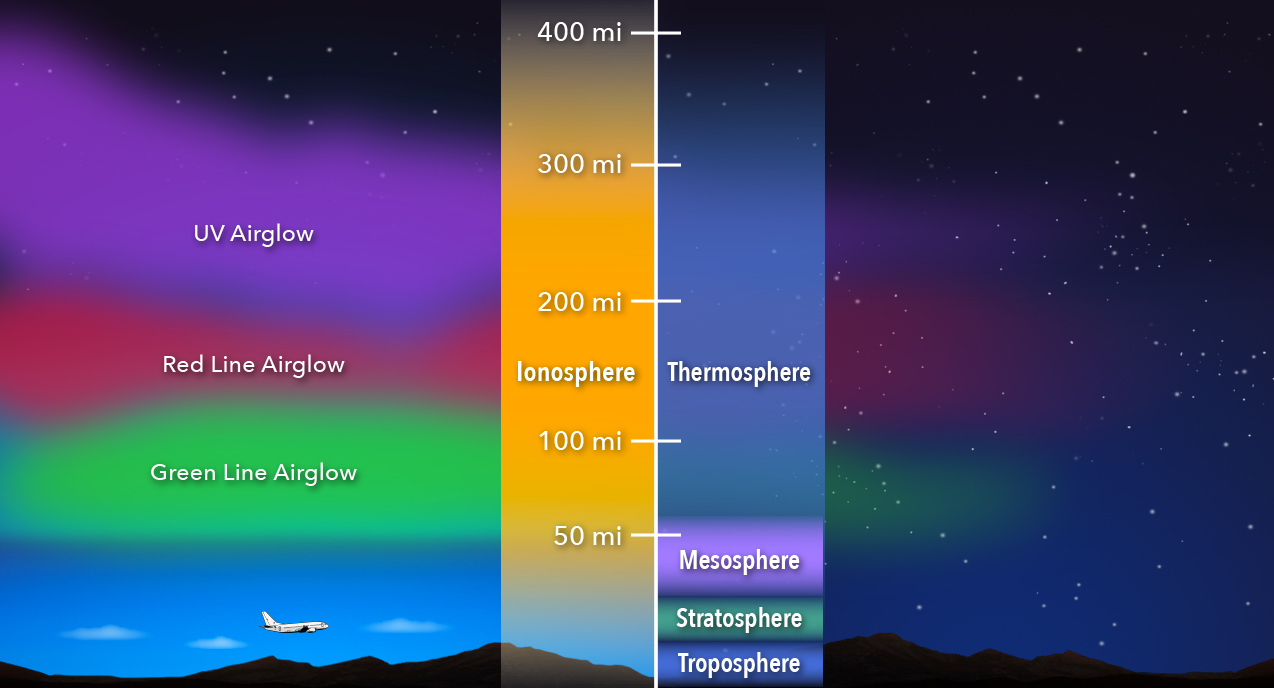Airglow Imagery
Airglow occurs when atoms and molecules in the upper atmosphere, excited by sunlight, emit light in order to shed their excess energy. The phenomenon is similar to auroras, but where auroras are driven by high-energy particles originating from the solar wind, airglow is sparked by day-to-day solar radiation. Airglow carries information on the upper atmosphere’s temperature, density, and composition, but it also helps us trace how particles move through the region itself. Vast, high-altitude winds sweep through the ionosphere, pushing its contents around the globe — and airglow’s subtle dance follows their lead, highlighting global patterns.

Photograph
How many of these can you find in this photograph: an aurora, airglow, one of the oldest impact craters on the Earth, snow and ice, stars, city lights, and part of the International Space Station? Most of these can be identified by their distinctive colors. The aurora here appears green at the bottom, red at the top, and is visible across the left of image. Airglow appears orange and can be seen hovering over the curve of the Earth. The circular Manicouagan Crater in Canada, about 100 kilometers across and 200 million years old, is visible toward the lower right and is covered in white snow and ice. Stars, light in color, dot the dark background of space. City lights appear a bright yellow and dot the landscape. Finally, across the top, part of the International Space Station (ISS) appears mostly tan. This image was taken from the ISS in 2012.
Credit: NASA

Photograph
If you could circle the Earth aboard the International Space Station, what might you see? Some amazing vistas, one of which was captured in this breathtaking picture in mid-2015. First, visible at the top, are parts of the space station itself including solar panels. Just below the station is the band of our Milky Way Galaxy, glowing with the combined light of billions of stars, but dimmed in patches by filaments of dark dust. The band of red light just below the Milky Way is airglow -- Earth's atmosphere excited by the Sun and glowing in specific colors of light. Green airglow is visible below the red. Of course that's our Earth below its air, with the terminator between day and night visible near the horizon. As clouds speckle the planet, illumination from a bright lightning bolt is seen toward the lower right. Between work assignments, astronauts from all over the Earth have been enjoying vistas like this from the space station since the year 2000.
Credit: NASA/JSC/ESRS

Photograph
Since November 2000, people have been living continuously on the International Space Station. To celebrate humanity's 15th anniversary off planet Earth, consider this snapshot from space of our galaxy and our home world posing together beyond the orbital outpost. The Milky Way stretches below the curve of Earth's limb in the scene that also records a faint red, extended airglow. The galaxy's central bulge appears with starfields cut by dark rifts of obscuring interstellar dust. The picture was taken by Astronaut Scott Kelly on August 9, 2015, the 135th day of his one-year mission in space.
Credit: NASA/Scott Kelly

Photograph
A composite photograph of star trails captured from the International Space Station. Bands of red and green airglow are also visible.
Credit: NASA/Don Pettit

Photograph
A composite photograph of star trails captured from the International Space Station. Bands of red and green airglow are also visible.
Credit: NASA/Don Pettit

Photograph
A composite photograph of star trails captured from the International Space Station. Bands of red and green airglow are also visible.
Credit: NASA/Don Pettit

Photograph
A composite photograph of star trails captured from the International Space Station. Bands of red and green airglow are also visible.
Credit: NASA/Don Pettit
Video
Lovejoy Comet over Southern Hemisphere
Credit: NASA
Video
Africa and Mideast at Night
Credit: NASA
Video
Northern Africa and Mideast (Evening)
Credit: NASA
Video
Bangkok to North Pacific
Credit: NASA
Video
City Lights over Middle East
Credit: NASA
Video
Western Quebec to Southern Ocean
Credit: NASA
Video
Aurora Borealis over Eastern North America
Credit: NASA
Video
Western Europe to India
Credit: NASA
Video
Eastern Europe to Southeastern Asia
Credit: NASA
Video
Halfway across the World
Credit: NASA
Video
International Space Station Near Aurora Borealis
Credit: NASA
Video
Aurora Borealis over Western Europe
Credit: NASA
Video
Lightning over Asia
Credit: NASA
Video
Over the Mediterranean Sea
Credit: NASA
Video
The Milky Way and Storms over Africa
Credit: NASA
Video
Milky Way on the Horizon
Credit: NASA
Video
Red and green swaths in the atmosphere, known as airglow, are seen in this video of Earth’s limb shot from the International Space Station.
Credit: NASA
Credits
Please give credit for this item to:
NASA's Goddard Space Flight Center
-
Support
- Joy Ng (USRA)
Release date
This page was originally published on Saturday, June 2, 2018.
This page was last updated on Monday, July 15, 2024 at 12:12 AM EDT.

![Complete transcript available.Music Credit: “Genosequence” by Alessandro Rizzo [PRS], Elliot Greenway Ireland [PRS] via Universal Production Music](/vis/a010000/a014400/a014464/14464_AWEOverview_Thumb.png)
![Music: "Nature Daydream" by Laurent Dury [SACEM], "Grape Picking" by Laurent Dury [SACEM] from Killer TracksComplete transcript available.Watch this video on the NASA Goddard YouTube channel.](/vis/a010000/a012900/a012902/12902_Airglow_VX-919658_large.00320_print.jpg)